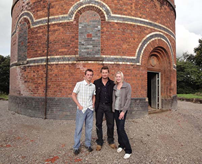Forge Lane Water Tower Case Study
During the conversion of a Grade II Listed Water Tower into a high specification home, Andy Critchlow, Director of AEW Architects was faced with the challenge of how to create a thermally efficient building from a structure that when originally built was never intended to be a home.
U-value Calculator
Start your U-value calculationPIR insulation for a grade II listed water tower conversion
| Products Used: | Celotex TB4000 , Celotex XR4000 |
|---|---|
| Sector: | Housing |
During the conversion of a Grade II Listed Water Tower into a high specification home, Andy Critchlow, Director of AEW Architects was faced with the challenge of how to create a thermally efficient building from a structure that when originally built was never intended to be a home. To achieve excellent thermal efficiency, low environmental impact and deliver a building fit for its new purpose, AEW specified a range of PIR insulation products from market leader Celotex.
Due to the nature of the building and to retain the existing brickwork aesthetic as agreed with the Local Planning Authority, the insulation had to be installed on the inside of the existing structure. AEW specified four Celotex products for various elements of the innovative refurbishment and remodelling project - filmed for Channel 4 show The Restoration Man, hosted by architect George Clarke.
To minimise loss of space, the insulation chosen had to be as thin as possible whilst achieving exceptional thermal performance. Celotex supplied its TB4000, GA4000 and XR4000, which were installed by specialist contractor Archway Building Solutions throughout the ground floor of the structure as well as three additional floors, along with all external walls and stud walls, the roof and a new extension.
Celotex TB4000 was used in the lining of the tower walls at a thickness of 40mm, fitted between the existing masonry and new stud wall, and GA4000 was used at a thickness of 65mm between the studs of the new wall. With a breadth of range unrivalled by any other PIR manufacturer, TB4000 and GA4000 offer multi-purpose insulation solutions.
In the floors, Celotex TB4000 was specified to eliminate the common occurrence of localised thermal bridges and to greatly reduce heat loss.
In the stud walls and roof to the rooftop extension, Celotex developed and supplied a specification to help achieve U-values of 0.21W/m²K and 0.20W/m²K respectively. To achieve this, XR4000 at a thickness of 120mm was installed into the roof top extension walls, with an additional 40mm thick TB4000 provided to insulate the new zinc-clad flat roof.
Key considerations
When using Celotex products, you need to satisfy yourself that use of the product meets all relevant national Building Regulations and guidance as well as local, national and other applicable standards relevant for your construction or application, including requirements in relation to fire and applicable height restrictions. In addition to the product datasheet, please refer to the following product documents:
- BBA certificates - where applicable to the application
- Declarations of Performance
- Health and safety datasheets
Celotex products should not be used in the external walls of buildings over 11 metres in height. Recent changes to Building Regulations mean that only non-combustible insulation or insulation of limited combustibility should be used in buildings of that height.



